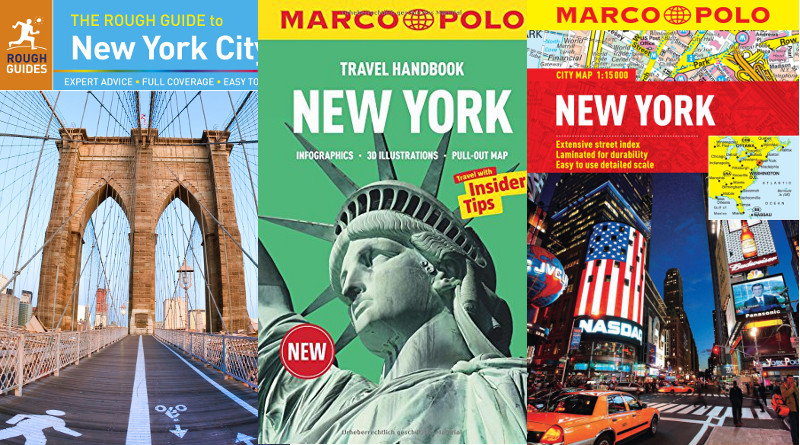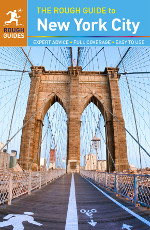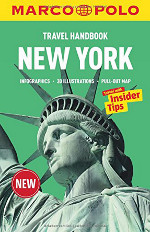Book review: New York city guides and maps
Disclosure: I received free copies of these maps and books for this review. I did not receive any payment and was not required to write a positive review. Links marked with (eBay⇒) or (Amazon⇒) are affiliate links. This means I get paid a small commission if you buy something after clicking on the links. This money helps to pay for the running of the website.
We finished our recent 2016 trip to New England with a couple of days in New York.
It was our first time in the Big Apple, so we were looking for an effective way to see some of the City’s big attractions — without breaking the bank or joining any organised tours, which are not our cup of tea.

Thanks to the generosity of Rough Guide and Marco Polo, we were armed with both The Rough Guide to New York and the Marco Polo Travel Handbook New York.
We also had a copy of the Marco Polo City Map New York, which was excellent — plenty of detail, and laminated so that it is waterproof and won’t tear easily. Good value for £4.99.
In this review, I’ll provide a summary of our thoughts on each of the guides.
The Rough Guide to New York City
 Rough Guides are always a reliable option, and this New York City guide is no exception. As you’d expect, it contains all the information you’re ever likely to need about the city’s different districts, tourist attractions and amenities. There’s plenty of good stuff about food and drink, hotels and museums, too.
Rough Guides are always a reliable option, and this New York City guide is no exception. As you’d expect, it contains all the information you’re ever likely to need about the city’s different districts, tourist attractions and amenities. There’s plenty of good stuff about food and drink, hotels and museums, too.
However, the reality is that the information in the Rough Guide is pretty similar to what’s in the Marco Polo New York guide. What’s different is the way that it’s organised. Which is best probably comes down to personal preference, so I’ll try to explain both in order to help you choose.
The majority of the Rough Guide is divided into two sections, The City and Listings.
The City is divided into 20 sections, each of which lists the attractions in one area of the city. For example, there’s a section covering the main attractions in Brooklyn. These City sections focus only on attractions. They don’t include information about eating and drinking, accommodation, shopping or nightlife — for example.
All of that information is included in the Listings section of the guide, which is divided into sections such as Accommodation, Restaurants, and LGBT New York. Each of these sections contains all the information on this topic for all areas of New York. All the listings are grouped by locality, using the same district names as in The City section of the guide.
Marco Polo Travel Handbook New York
 The approach taken by Marco Polo is rather different. In the Marco Polo Travel Handbook New York, the majority of the guide is divided into two sections, Enjoy New York and Sights From A to Z.
The approach taken by Marco Polo is rather different. In the Marco Polo Travel Handbook New York, the majority of the guide is divided into two sections, Enjoy New York and Sights From A to Z.
(I should also say that the Marco Polo guide includes a detailed pull-out map, which the Rough Guide does not.)
Enjoy New York contains chapters covering topics such as Accommodation, Entertainment and Food and Drink. Each of these includes lots of background information and covers the whole of New York City. But these sections aren’t divided geographically in the way that the equivalent parts of the Rough Guide are.
What’s done instead is that where appropriate, places are listed by price. So, for example, you can find listings of cheap, mid-price and expensive restaurants and hotels. These won’t be in any particular geographic order, but they are numbered and shown on a map in the guide.
The second section of the book, Sights From A to Z, is simply a detailed listing of all New York’s main attractions. These start with the American Museum of Natural History and end with the Whitney Museum of American Art and the 9/11 Memorial and One World Trade Center.
This section is indexed by the name of the attraction. In my view, it works very well. I found it easier to quickly find information about — say — the Lincoln Center for the Performing Arts using the Marco Polo guide, than the Rough Guide.
Is this the kicker? The Marco Polo guide also had one killer feature that worked brilliantly well for us. As I mentioned, we don’t like organised tours of any kind. We also prefer to explore cities on foot. So the Tours section of the Marco Polo guide was brilliant for us.
There are five walking routes suggested, each of which takes in a different selection of attractions, logically grouped together. We found that by doing part of Tour 1 on the day we arrived and most of Tour 2 on the second day, we’d seen almost everything we wanted to see given the time available.
It may sound lazy, but these tours are very well thought out and are easy to follow. Given enough time and effort, we could have come up with the same tours ourselves using a map and a list of attractions. But the Marco Polo tours gave us exactly what we wanted, with a running commentary on what we were seeing and where to go next.
Our verdict
Both guides were good, but the Marco Polo guide worked best for us in New York, due to the way information was organised and the inclusion of the walking tours.
However, I should say that we weren’t really interested in information about shops, hotels or food and drink. Our main focus was on seeing the sights we wanted to see. For this, we found the Marco Polo guide was much easier to use and follow than the Rough Guide.
If your focus is more on exploring individual areas of the City, and you’re the kind of person who likes to plan where to eat and drink, then I suspect the Rough Guide might work better for you.
Both are good guides to New York — which is best for you depends on how you like to operate when visiting a city.
Buy these guides on Amazon (Amazon⇒) or from Rough Guides and Marco Polo.
